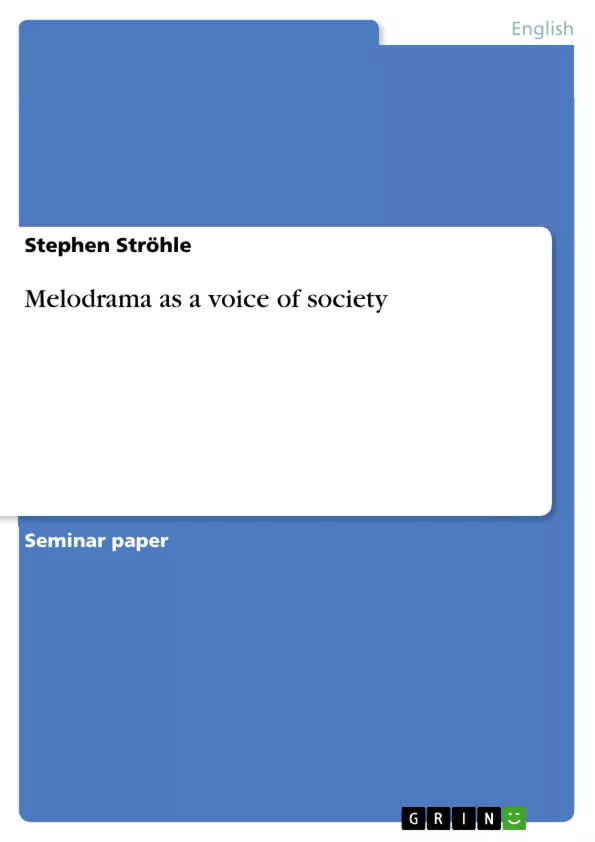Melodrama was already successfully performed in France, Germany and especially in England. When the Melodrama came to the United States it first had to be Americanized. So the American authors had to invent a new kind of Melodrama which had an American spirit. What they did first was to copy successful European plays and rewrite them for American conditions. By the late 19thcentury real American melodramas were written including a lot of action, violence and often the use of huge machinery. “Melodrama became a direct expression of American society and national character”¹ as well as technological progress and its dangers. What I am going to do now is to deal with the intentions of the Americanized Melodrama. I think a brief definition of what a melodrama is should be enough because so many others have already taken its definition into pieces. Of more importance is the way the American society is shaped at that time and the way the Melodrama influences and criticises society. I will try to explain the function of a melodrama and how it is used as a voice of society. The example ofUnder the Gaslightby Augustin Daly will help us to understand the functions of the melodrama and how they are implemented.
Table of Contents
- Introduction
- I The Melodrama
- II Function and Structure
- a) Methods of the authors
- b) Aims of a melodrama
- III The author Augustin Daly
- IV Under the Gaslight: A typical Melodrama
- a) A brief summary
- b) A critical analysis of Under the Gaslight
- V Conclusion
Objectives and Key Themes
This work examines the emergence and function of American melodrama, specifically through the lens of Augustin Daly’s play "Under the Gaslight." The author explores how American melodramas were influenced by European works and adapted to reflect American society, its technological advancements, and social challenges.
- The evolution of American melodrama from European influences.
- The role of melodrama in shaping and reflecting American society.
- The characteristics and conventions of melodrama, including its polarized worldviews and emotional impact.
- The portrayal of social class divisions and societal anxieties in American melodrama.
- The use of spectacle and sensationalism in melodrama to engage audiences.
Chapter Summaries
The introduction provides an overview of the Americanized melodrama and its development, highlighting the adaptation of European plays to fit American contexts. It sets the stage for examining the function of melodrama as a voice of society, using "Under the Gaslight" as a case study.
Chapter I delves into the definition and characteristics of melodrama, placing it within the broader context of romanticism. The chapter explores how melodramas use heightened emotions, sensational scenes, and clear-cut characterizations to engage audiences and offer emotional catharsis.
Chapter II focuses on the structure and methods of American melodrama. It examines the standardized formulas and methods employed by playwrights to create melodramatic works. The chapter explores the use of spectacle, violence, and dramatic elements to capture audiences, as well as the simplification of characters and plots to facilitate emotional engagement.
Keywords
The primary themes and concepts discussed in this work include American melodrama, social commentary, class divisions, industrialization, spectacle, emotional engagement, and the play "Under the Gaslight" by Augustin Daly. The text explores the relationship between theatrical conventions and societal realities, analyzing how melodrama served as a reflection and critique of the changing American landscape.
- Arbeit zitieren
- Stephen Ströhle (Autor:in), 2001, Melodrama as a voice of society, München, GRIN Verlag, https://www.grin.com/document/53543



